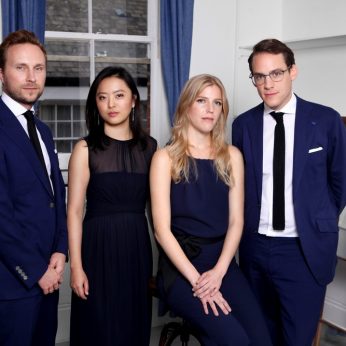Composer: Béla Bartók (b. 1881 - d. 1945)
Performance date: 29/06/2022
Venue: Bantry House
Composition Year: 1934
Duration: 00:34:12
Recording Engineer: Eduardo Prado, Ergodos
Instrumentation: 2vn, va, vc
Instrumentation Category:String Quartet
Artists:
Doric String Quartet (Alex Redington, Ying Xue [violins], Hélène Clément [viola], John Myerscough [cello] -
[quartet]

Béla Bartók [1881-1945]
String Quartet No.5 [1934]
1. Allegro
2. Adagio molto
3. Scherzo. Alla bulgarese – Trio
4. Andante
5. Finale: Allegro vivace – Presto
Certain paradoxes appeared during the years separating Bartók’s Fourth String Quartet composed in 1928 and his Fifth from 1934. One of these was the increasing resolve exhibited in his music, in contrast with the despair he felt for the times in which he lived. This political scene was distressing both at home – the authoritarian, right-wing regime of Miklós Horthy – and more widely in Europe with the rise of Fascism. Bartók protested in 1931 when Toscanini was physically assaulted by Italian fascists for refusing to conduct their marching anthem, the Giovinezza. In the same year, Bartók became a cultural diplomat to the ill-fated and ineffectual League of Nations where the urgent humanitarian nature of his contributions replaced his former, nationalist concerns. From 1933, after giving the premiere of his Second Piano Concerto in Frankfurt, Bartók refused to perform in Germany and never returned there in his lifetime.
But his pessimism over the future of Europe was not manifest in any further inward constriction of his compositional style – in fact, the opposite. The major works of this period – such as the Cantata Profana (1930) and the Second Piano Concerto – display an outgoing transparency and mature assurance which evolved from the unflinching experimentation of the 1920s.
Similarly, there was a paradox between his virtual withdrawal from public life in Budapest and an increased openness in his music. The Horthy regime’s antipathy meant that little of Bartók’s music was performed in Budapest. He became alienated within his own country where he now felt reluctant to play his own music. After the Fourth String Quartet in 1928, none of his works was premiered in Hungary. Likewise, from that time, the only commissions he received were from outside Hungary, the Fifth Quartet being commissioned by the American patroness of contemporary music, Elizabeth Sprague Coolidge. The increasing openness in his music is exemplified in the Fifth String Quartet, the wider intervals of whose long, diatonic melodic lines are in sharp contrast with the terse, semi-tone-stepped motivic material which so intensified the first two movements of the Fourth.
Bartók’s satisfaction with the Fourth’s symmetrical, five-movement arch structure led him to use the same form in the Fifth Quartet. But where the Fourth’s cornerstone was a slow movement, in the Fifth it is the third movement Scherzo – itself in symmetrical ABA form but based on asymmetrical Bulgarian rhythms – flanked on both sides by slow movements which in turn are flanked by interrelated outer movements.
The Allegro first movement is dominated by the powerful, at times triumphant, chords that open the work, a clear emphatic statement, here I am, Bartók the composer, you need to listen to me. There is a quieter and more lyrical, contrasting second theme that tries to hold its own.
Of the two slow movements, the meditative Adagio molto works three ideas: ethereal exchanges of gentle trill figures; a chorale figure accompanied by a melodic line in the violin; and sighing, two-note motifs. Then, on the far side of the central Scherzo, these same three ideas are each presented as variations in the Andante which also introduces one further idea into the mix.
The lively Finale continues Bartók’s renewed interest in classical forms after the opening Allegro in sonata form and now the Finale a rondo. Here there is much contrapuntal activity, including an intricate preoccupation with mirror forms and correspondences that are strengthened when the Finale eventually reprises material from the first movement, and additionally and non-symmetrically recalls other movements. The sudden intrusion of a little folk song into this highly organised movement is a brief glimpse of another world. The main rondo quickly returns and concludes with a typical flourish.
Michael Dungan / Francis Humphrys
Copyright © 2025 West Cork Music. All rights reserved.
Designed and developed by Matrix Internet